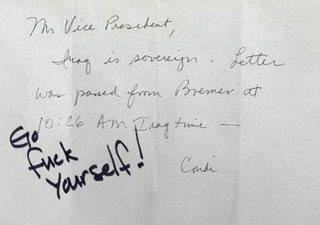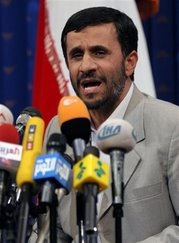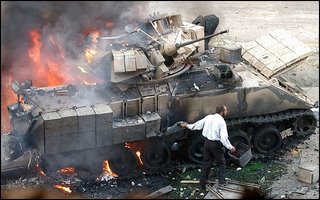
NEW ERA IN WARFARE
When the Hezbollah militia fought the Israeli ground forces to a standstill in Lebanon last month, it was the military equivalent of Jackie Robinson joining the Brooklyn Dodgers in 1946. Only the game which has opened up is the fate of nations, and their home-grown militia is now being called the "Hezbollah Army" (HA) by military analysts. Talk about an upgrade, and the Hezbollah imprimatur will be stamped on much more than Israeli ass. Militias across the world will be inspired by, and will copy, the tactics which led to their victory, and new militias will form and be organized along similar lines. So how did they do it?
First, Hezbollah built tremendous long-term goodwill amongst the populace by engaging in charity, giving people food, rebuilding housing and infrastructure the last time Israel came in to wreck stuff. And they kept doing good works to become not just part of the social fabric, but the framework of social organization in southern Lebanon. As soon as this cease-fire was declared, they give everyone whose housing was destroyed $12,000. This explains in part the high morale and the commitment of their fighters which were the most basic element of victory. But they did something much more innovative, even fascinating, and of longer term importance in military history. They beat what was purportedly the best standing army in the world, and they did it by combining common-sense use of new technology with sound military strategy and excellent preparation to achieve a strange force multiplier effect that isn't yet completely understood. Because if it were understood, Israel would've won. But I think they figured out how to achieve a force dispersion multiplier effect on the modern battlefield. In plainer English, they achieved something like what Colonial militias did against Redcoats in the American Revolutionary War. Below is my first attempt at analysis.
If employed correctly, force dispersion can become a force multiplier, as
the Hezbollah Army (HA) just demonstrated in
Lebanon. Part of the defenders' operational success
against the Israeli Defense Forces (IDF) was
undoubtedly due to the increasing effectiveness and
proliferation of cheap LOS/LOF/IED tactical force projection
devices against high-value ground or air targets (a
trend likely to further accelerate). However much
of the HA's effectiveness should be attributed to good
force discipline, application of fairly sophisticated
command and control techniques, and making the best of
a defender's natural intelligence advantage. Yet each of these
in turn would probably have been much less effective
if not based in exceptionally well-prepared and
concealed underground bunkers.
The strategy employed
appears similar to one by ants vs. elephants. Ants
cannot stop elephants in their tracks, but they can
deny full ownership of territory, even channel an elephant
advance by converging to attack an offending elephant's
orifices, quickly dispersing back into anthills once
the animal moves out of a convergence zone. If the
elephant fails to retreat quickly enough, the
converging ants reach critical mass and the elephant goes crazy from pain,
loses its ability to effectively retreat and eventually is eaten alive.
Regardless of metaphor, the IDF failed to fully secure
significant ground in Lebanon, and was thrown back
repeatedly from stated objectives it had meticulously
wargamed over for at least 5 years.
The defense of Lebanon
could be termed "one cell, many bunkers." It
apparently relied heavilyy upon the principle of
defense in depth, creating flank exposure
opportunities by conserving formations in deep bunkers
while motorized columns passed either unmolested or
lightly opposed on the road/trail network. Fresh
formations, perhaps up to platoon-sized, would emerge
to briefly re-infiltrate the battlefield for
hit-and-run ambushes and even sometimes for more
protracted engagements. In the future, a similar
cell-and-bunker technique might also be employed in
hidden militia-driven offensive efforts to infiltrate
and gradually take control of ground over time, for
example in Palestine. For the present, IDF prospects
for dislodging or defeating HA forces appear dim; even
if its maximum conventional means were employed, IDF
losses might be correspondingly high, and budgetary
expenses surely would be so.
It is true that side-scanning radar to expose bunkers,
mines, and IEDs would be helpful. Nonetheless an array
of widely available fundamental technology
developments have conspired to put blitzkrieg on the
wane and militia on the rise, one elephant is a very
expensive organism whereas an ant is comparatively
quite cheap, and for the immediate term formation
movements must adapt accordingly. In order to
protect high-value weapons, infantry must move out
well in front them.
It is now technically feasible for a 13-year old with
an internet connection to launch and control an
unmanned aerial vehicle or cruise missile, or fire a
wire-guided missile, from his or her bedroom. Against
this technology backdrop, armor is not a good
investment; it can be expected that helicopters will
become more and more operationally vulnerable, perhaps
being relegated to stand-off weapons best deployed in
well-secured areas or from shoot-and-scoot forward
stances.
Due to the demonstrably increasing proliferation of
cost-effective countermeasures of local or regional
manufacture, securing ground for deployment of armor,
helicopter, and eventually close fixed-wing air
support should require more intensive and thorough
battlefield preparation. If Lebanon provides a
tactical model, achieving required levels of security
may largely be a function of locating, overwhelming,
and destroying Lebanon-style bunkers in order to drive
corresponding cells above ground where they can be
eliminated with existing stand-off weapons systems.
This might also include house-to-house searches and
temporary but humane removal of the local populace to
a secured camp. Appropriate tactics and weapons should
be developed with such objectives in mind, with an eye
to cost reduction, or elimination, of some currently deployed
weapons systems.


















